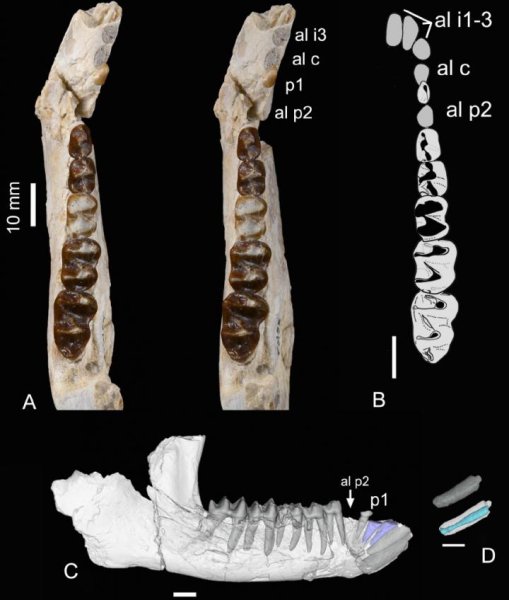@WFS,World Fossil Society,Riffin T Sajeev,Russel T Sajeev
Long before rhinoceros, giraffes, hippos, and antelopes roamed the African savannah, a group of large and highly specialized mammals known as embrithopods inhabited the continent. The most well known is Arsinoitherium, an animal that looked much like a rhinoceros but was in fact more closely related to elephants, sea cows, and hyraxes. Now, researchers reporting in Current Biology on June 28 offer a glimpse into this ancient past with the discovery of the earliest and most ancient embrithopod yet described.
The approximately 55-million-year-old fossilized dental remains found in the first lower Eocene levels of the Ouled Abdoun phosphate basin in Morocco represent two new species in the genus Stylolophus, the researchers report. The earliest embrithopods were previously known from 48-million-year-old fossils collected in Africa and Turkey.

This figure show the lower jaw of Stylolophus minor, holotype of the new species. C is 3-D model reconstructed from CT scans. It shows by transparency the teeth roots, and especially those of the anterior incisors that are enlarged and oriented (tilted) horizontally as in the early proboscidean Phosphatherium. Length of M1-3 series: 38.5 mm. Scale bar, 10 mm.Credit: Photographs by Philippe Loubry (MNHN). Drawing by Charlène Letenneur (MNHN)
“The embrithopods were large and strange extinct mammals that belonged, together with hyraxes and elephants, to the early megaherbivorous mammalian fauna that inhabited the island Africa, well before the arrival about 23 million years ago of the Eurasian ungulate lineages such as the artiodactyls, including giraffes, buffalos, hippopotamus, and antelopes, and the perissodactyls, including zebras and rhinoceros,” says Emmanuel Gheerbrant of CNRS-MNHN in Paris, France. “They belong to the old endemic African fauna.”
Gheerbrant said that the origins of embrithopods had been uncertain, with two known co-existing families: one in Africa and the other in Turkey and Romania. It’s been unclear what the exact relationships of the embrithopods were with respect to sea cows and elephants.
The new phylogenetic study of the two species of Stylolophus found in Morocco confirms that they are basal embrithopods. It also shows that the extinct Embrithopod order is ancient, predating the divergence of the sea cows and elephants.
“Comparative anatomy of the new Moroccan species shows that the highly specialized embrithopod teeth derived from the ancestral dental morphology of all paenungulates, a clade including elephants, sea cows, and hyraxes, with the W-crested molars seen in some of the oldest hyracoids,” the group including hyraxes, Gheerbrant says. “The specialized design of the teeth with two transverse ridges, known in the most advanced forms such as Arsinoitherium, is a convergence of the embrithopods and the extant group of tethytheres, including manatees and elephants, towards leaf eating, which was favored by the ancient herbivorous niches available on the African island.”
The new species S. minor — which was unusually small at about the size of a sheep — is also the first to show the presence in embrithopods of enlarged and anteriorly inclined incisors, in the form of incipient tusks, as seen in the early ancestors of the group including elephants.
The early age and primitive state of Stylolophus, together with the high-level relationships (paenungulate and afrotherian), all support an African origin of the order Embrithopoda, the researchers say. The findings suggest that the Paleoamasiidae family found in Turkey arrived on the Eurasian shores of the Tethys Ocean (an ocean during much of the Mesozoic Era and the Paleogene period located between the ancient continents of Gondwana and Laurasia), after an early dispersal of an African ancestor resembling Stylolophus across the sea.
The researchers say that they’ll continue to search for paleontological evidence elucidating the evolutionary history and relationships of African ungulate-like mammals and insectivore-like afrotherian mammals, including golden moles, elephant shrews, tenrecs, aardvarks, and hyraxes. They’ll also continue the search for the enigmatic early roots of all placental mammals in Africa, going back even further in time to the Cretaceous Period.
- Emmanuel Gheerbrant, Arnaud Schmitt, László Kocsis. Early African Fossils Elucidate the Origin of Embrithopod Mammals. Current Biology, 2018; DOI: 10.1016/j.cub.2018.05.032
@WFS,World Fossil Society,Riffin T Sajeev,Russel T Sajeev



 July 1st, 2018
July 1st, 2018  Riffin
Riffin  Posted in
Posted in  Tags:
Tags: 